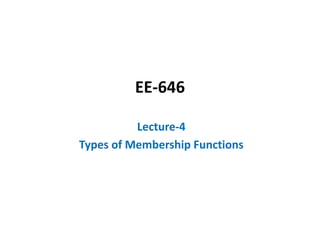
Types of Membership Functions
- 1. EE-646 Lecture-4 Types of Membership Functions
- 2. Basic Definitions 5-Sep-12 2EE-646, Lec-4
- 3. Symmetric MF A fuzzy set is symmetric if its membership function (MF) is symmetric about a certain point x = c and we write ( ) ( );A Ac x c x x Xµ µ+= − ∀ ∈ 5-Sep-12 3EE-646, Lec-4
- 4. Decreasing MF (Open Left) A fuzzy set is open left or decreasing if membership values continuously decrease (from 1) as we increase x lim ( ) 1 & lim ( ) 0A A x x x xµ µ →−∞ →+∞ = = 5-Sep-12 4EE-646, Lec-4
- 5. Increasing MF (Open Right) A fuzzy set is open right or increasing if membership values continuously increase (up to 1) as we increase x 5-Sep-12 5EE-646, Lec-4 lim ( ) 0 & lim ( ) 1A A x x x xµ µ →−∞ →+∞ = =
- 6. Approximating MF (Closed Fuzzy Set) A fuzzy set is closed if values on both ends decrease to zero i.e. lim ( ) lim ( ) 0A A x x x xµ µ →−∞ →+∞ = = 5-Sep-12 6EE-646, Lec-4
- 7. Types of Membership Functions • Increasing Type (Γ-function, S-function) • Decreasing Type (L or Z-function) • Approximation Type (Triangular function, Trapezoidal function, Gaussian Function, Bell function) 5-Sep-12 7EE-646, Lec-4
- 8. Γ- Function 5-Sep-12 8EE-646, Lec-4 ( ) 0, : , 1, , x x x x x α α β β α α β β α < Γ = ≥ − ≤ < −
- 10. S - Function 5-Sep-12 EE-646, Lec-4 10 ( ) 2 2 0, 2 , : , , 1 2 , 1, x x x S x x x x α α α β γ α α β γ α β γ γ α γ < − ≤ < − = − − ≤ < − ≥
- 11. 5-Sep-12 11EE-646, Lec-4 By symmetry, we can reduce the no. of parameters and we can take 2 α γ β + = µ (x) x
- 12. L or Z - Function 5-Sep-12 12EE-646, Lec-4 ( ) 1, : , , 0, x x L x x x α α α β α β β α β < − = ≤ < − ≥
- 14. Triangular Function 5-Sep-12 EE-646, Lec-4 14 ( ) ( ) ( ) ( ) ( ) 0 , / , or : , , / , 0 , x x x x x x x α α β α α β α β γ γ γ β β γ γ ≤ − − < ≤ ∆ Λ = − − < ≤ >
- 15. µ (x) x 5-Sep-12 15EE-646, Lec-4
- 16. Trapezoidal or Π-Function 5-Sep-12 EE-646, Lec-4 16 ( ) ( ) ( ) ( ) ( ) 0 , / , : , , , 1 , / , 0 , x x x x x x x x α α β α α β α β γ δ β γ δ δ γ γ δ δ ≤ − − < ≤ Π= < ≤ − − < ≤ >
- 17. 5-Sep-12 17EE-646, Lec-4 µ(x) x α β γ δ
- 18. Gaussian Function • Also known as normalized distribution function. It is defined as • It can be used as inc, dec or approx. type function by controlling only two parameters 5-Sep-12 18EE-646, Lec-4 ( ) 2 1 Gaussian : , exp 2 c c x x x x σ σ − = −
- 19. Gaussian Function 5-Sep-12 EE-646, Lec-4 19 xc x µ(x)
- 20. Generalized Bell Function • Crossover points are c ± a • BW is 2a • Flat on top 5-Sep-12 EE-646, Lec-4 20 ( ) 2 1 Bell : , , 1 b x a b c x c a = − +
- 21. Generalized Bell Function 5-Sep-12 EE-646, Lec-4 21
- 22. Effect of Change in parameters 5-Sep-12 22EE-646, Lec-4
- 23. Sigmoidal Function • Used extensively in ANN theory • Please see yourself 5-Sep-12 23EE-646, Lec-4
- 24. Today’s Task • Find out the MATLAB commands for these functions and generate some sample functions 5-Sep-12 24EE-646, Lec-4
